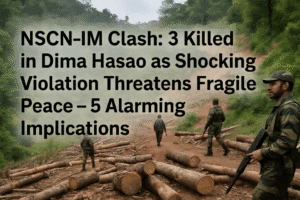NSCN-IM Clash: 3 Killed in Dima Hasao as Shocking Violation Threatens Fragile Peace – 5 Alarming Implications
A recent clash in Assam’s Dima Hasao district, where Indian security forces killed three NSCN-IM cadres, has ignited tensions over alleged violations of a decades-old ceasefire. The NSCN-IM, a Naga separatist group engaged in peace talks with India since 1997, condemned the operation as a “provocative breach” of agreed terms prohibiting offensive actions in conflict zones. The group claims the area as historic Naga territory, though it falls under Assam’s jurisdiction—a point of longstanding dispute.
Analysts warn the incident risks derailing fragile negotiations, already strained by unresolved demands for Naga sovereignty, including a separate flag and constitution. While Indian authorities have yet to respond, past operations in the ethnically contested region have been justified as counterinsurgency measures. Civil society groups fear escalating violence, urging transparency and renewed dialogue to prevent collapse of the truce. The clash underscores the precarious balance between security enforcement and political compromise in India’s Northeast, where overlapping ethnic claims and stalled peace processes threaten regional stability.

NSCN-IM Clash: 3 Killed in Dima Hasao as Shocking Violation Threatens Fragile Peace – 5 Alarming Implications
On April 29, 2025, three cadres of the National Socialist Council of Nagalim (Isak-Muivah), or NSCN-IM, were killed in Assam’s Dima Hasao district (historically called NC Hills). The NSCN-IM, a prominent Naga separatist group, has accused Indian armed forces of violating the Agreed Ground Rules of their ceasefire by launching an “illegal and provocative” operation in what they claim as “Naga territory.” The group’s leadership condemned the act as a deliberate breach of trust during sensitive political negotiations with New Delhi.
Background: A Decades-Long Struggle
The NSCN-IM, formed in 1980, has sought sovereignty for Naga-inhabited regions across Northeast India and Myanmar. A ceasefire agreement with India in 1997 paused decades of insurgency, but peace talks have stalled over demands for a separate Naga flag and constitution. The “Agreed Ground Rules” established under this truce prohibit offensive military actions by either side, emphasizing protection of civilians and property.
The Dima Hasao district, where the clash occurred, sits at the intersection of Assam, Nagaland, and Manipur—a region with overlapping ethnic claims and a history of tensions between Naga groups and Assam’s state government.
Violation or Enforcement?
The NSCN-IM asserts that the Indian forces ignored Clause (a) of the ceasefire, which bans raids, ambushes, or operations causing civilian harm. The group warns that such actions “threaten peace efforts” and could collapse the truce.
However, Indian authorities have long accused NSCN-IM of exploiting ceasefire terms to expand influence in disputed areas like Dima Hasao, often clashing with rival factions or Assam’s Dimasa communities. While the Indian government has yet to comment on this incident, past operations in the region have been framed as counterinsurgency measures against “unauthorized militant activity.”
Implications for the Peace Process
Analysts highlight the fragility of the Naga peace talks. “This incident risks hardening positions,” says Dr. Namrata Goswami, a Northeast conflict expert. “The NSCN-IM’s reference to ‘Naga territory’ in Assam directly challenges state boundaries, a red line for New Delhi.”
The group’s appeal to international mediators, including the Ceasefire Monitoring Group, underscores dwindling faith in bilateral resolutions. Meanwhile, local civil society groups in Nagaland and Assam fear renewed violence. “Civilians always bear the brunt when ceasefires unravel,” notes a spokesperson for the Naga Mothers’ Association.
A Path Forward?
The NSCN-IM maintains its “commitment to peace” but warns of retaliatory measures if aggression continues. For dialogue to resume, experts suggest:
- Transparent Investigation: An independent probe into the incident to assign accountability.
- Dialogue Reboot: Addressing core issues like territorial autonomy while ensuring state sovereignty.
- Community Engagement: Involving grassroots organizations to mitigate ethnic tensions in contested zones.
The Bigger Picture
This clash reflects broader challenges in India’s Northeast, where complex ethnic identities collide with geopolitical boundaries. With both sides holding firm to historical grievances, the Dima Hasao incident serves as a critical test for conflict resolution—and a reminder that lasting peace requires more than ceasefire agreements; it demands political courage and compromise.
You must be logged in to post a comment.